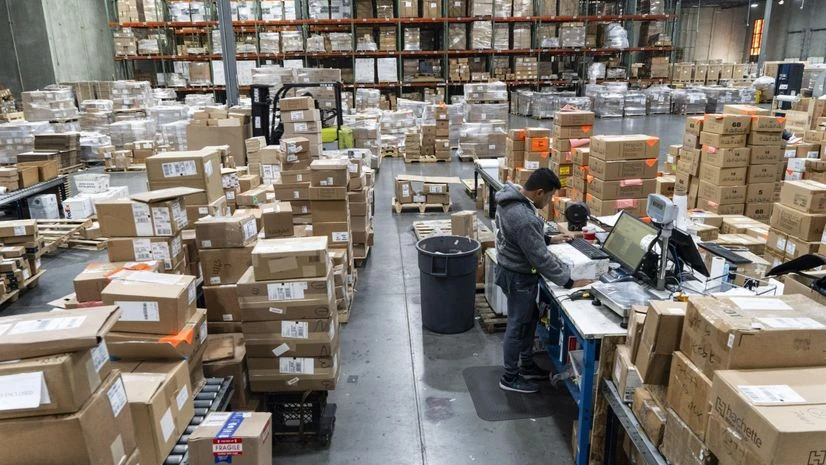By Molly Smith and Enda Curran
On the eve of the US presidential election, a snapshot of recent data shows the winner will inherit an economy that’s humming, powered by American consumers who continue to spend despite years of high prices and interest rates.
The economy expanded at a robust pace in the third quarter, continuing several years of solid growth, and the unemployment rate has remained low. That’s a far cry from the recession economists had long expected.
Granted, it’s not all positive. Job growth slowed to the weakest pace since 2020 in October, a month distorted by severe hurricanes and a major strike, and the path to cooler inflation continues to prove bumpy. Meanwhile, high mortgage rates and house prices have pushed homeownership further out of reach for many Americans.
Voters have long been frustrated with the economy under President Joe Biden, which has featured the worst inflation in a generation, a housing affordability crisis and some of the highest interest rates in decades. At the same time, price pressures have rarely subsided so quickly, let alone without triggering a recession.
Also Read
According to the so-called misery index, which adds up the inflation rate and unemployment rate, Americans shouldn’t be miserable at all. The widely used welfare gauge is lower than in any recent election year, except for 2016.
It’s a difficult message to convey for Vice President Kamala Harris, who’s tried to tout the administration’s victories while communicating to voters how she’ll be different from her boss. Former President Donald Trump has cast his opponent as overseeing “the worst economy in your life” in his bid to return to the White House, but growth is still powering ahead.
Here’s the latest picture of the US economy heading into Election Day:
Labour Market
Nonfarm payrolls increased just 12,000 last month, hampered by Hurricanes Helene and Milton as well as a strike at Boeing Co. But hiring over the previous two months was weaker than previously thought, indicating the labor market is still softening beyond the temporary factors.
The job market is moderating from the unsustainable strength of the pandemic recovery, but economists certainly wouldn’t describe it as weak. Unemployment, while somewhat higher in recent months, is still historically low, and wage growth has outpaced inflation for more than a year. Employers are also still trying to fill over 7 million job openings.
“We think it’s unlikely that we are seeing a tipping point in the labor market just yet,” said Lauren Goodwin, an economist and chief market strategist at New York Life Investments. “Jobless claims are low and corporate profits are healthy, suggesting little imminent risk of layoffs picking up.”
Inflation
Despite the strength of the labor market, the Biden-Harris administration has been dogged by inflation, peaking above 7 per cent in mid-2022. It rose 2.1 per cent in September from a year ago — just a touch above the Fed’s 2 per cent goal — according to data out Thursday.
Disinflation has stemmed from a few areas. Falling gas prices — as well as costs for other energy commodities — have contributed a lot, and businesses have found it more difficult to pass on higher prices to consumers. Supply chains are also back in order after the upheaval from the pandemic led to higher shipping costs and lengthy delivery times.
But the ride down has been choppy. Price growth actually picked up in September from the prior month, and at times, inflation has moved sideways for months at a time. That’s been frustrating for consumers, especially since lower inflation means prices are just rising more slowly, not declining.
The candidates are trying to address voters’ financial angst. Trump said last month he’d consider exempting police officers, firefighters, active duty military and veterans from paying taxes. Harris, meanwhile, has proposed an expansion of the child tax credit and pledged a ban on price gouging. Both have floated ending taxes on tipped wages.
Growth
The US has been an out-performer among global advanced economies, in part due to the pandemic-era stimulus Congress injected into the economy. The International Monetary Fund in October boosted its estimate for US growth this year to 2.8 per cent and 2.2 per cent next year on stronger consumption.
Fueling that expansion has been productivity growth and healthy corporate and household balance sheets along with booming asset prices, said Rob Subbaraman, head of global macro research at Nomura. “The dynamic and flexible US economy has benefited from the Covid reset more than most.”
Still, there are challenges. US debt — already set to reach 99 per cent of GDP this year — is forecast to continue to rise, and Bloomberg Economics estimates that Trump’s tax cuts could take it to 116 per cent in 2028 while Harris’ more conservative proposals means it would stay on a path to 109 per cent.
Consumers
Padded by savings cushions and pay raises, Americans have surprised economists time and again with their vigor to spend. September was no exception. But signs of consumer stress are brewing, with Americans’ fears of delinquency rising to the highest since the onset of the pandemic. The saving rate has also steadily declined this year.
Furthermore, not all Americans have enjoyed the strong economy. A rising stock market has helped propel overall household net worth to a record, but many Americans don’t hold significant amounts of equities and have been accumulating debt in recent years amid elevated interest rates.
The divide has also been increasingly partisan. The University of Michigan’s consumer survey has long shown that voters who identify with the president’s party are generally more optimistic compared to those on the other side. The gap between respondents’ views on their financial situation widened to a record in September in data dating back four decades, according to an analysis by Bloomberg Economics.

)